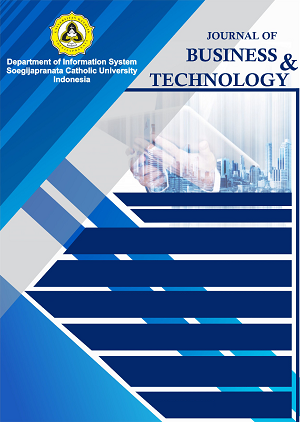The Use of An Accounting Information System for Monitoring Website-Based Sales Call Activities in Garment Company
Abstract
There are several ways that can be used to increase sales, one of which is using a sales call. At PT. Ricky Mumbul Daya, sales call is one of the main activities carried out to increase sales. Although the process of recording revenues and costs related to sales call activities at that company has used the system, but the process is still not optimal. This is because the data input process is only done by the cashier. Meanwhile, the monitoring process is still done manually. The purpose of this research is to create a Website-Based Accounting Information System for Sales Call Monitoring and tested whether the level of performance and effort expectations of the system has an influence on user behavioral intention. The system development method used is the System Development Life Cycle. Meanwhile, to test the level of the three variables, it will begin with collecting data with a questionnaire and then the data will be analyzed using several testing methods. The result of this research is that the information system created can complete the expected tasks and concluded that the level of performance and effort expectations of the system have an influence on the user’s behavioral intention.
Keywords
Full Text:
PDFReferences
M. U. Sinurat, “Sales Call Strategy in Marketing Tour Packages of PT. Widy Cahaya Cemerlang to Overcome Travel Competition in Medan,” 2017, [Online]. Available:https: //www.usu.ac.id/id/fakultas.html.
D. Anjani, "Designing a Computer-Based Payroll Accounting Information System at PT Ladang Makmur," pp. 7–25, 2016, [Online]. Available: system.
A. Herliana and P. M. Rasyid, “Information System Monitoring Software Development at the Web-Based Development Stage,” vol. 3, no. 1, pp. 41–50, 2016.
M. L. Mustofa, Monitoring and Evaluation: Concepts and Applications for Student Development, no. I. 2012.
A. P. Arum, "Design of Web-Based Cash Receipt Accounting Information System at Batik Pramanca," p. 267, 2016.
V. Muntihana, "Analysis and Design of Web and Android-Based Information Systems at Lisda Medica Dental Clinic in Bulukumba Regency, South Sulawesi," p. 99, 2017.
H. Sisworo, “Performance Accountability Report 1 of the Department of Transportation, Communication and Information of Blitar City in 2015,” 2016.
FA Utami, “What is BOPO?,” www.warta Ekonomi.co.id, 2020. https://www.wartaekonomi.co.id/read300269/apa-itu-bopo (accessed Nov. 03, 2021).
Gie, "Profitability Ratio: Definition, Benefits, Types and Method of Calculation," accurate.id, 2019. https://accurate.id/akuntansi/rasio-profitabilitas-dalam-acuntansi/#Apa_Rasio_Profitabilitas_yangPaling_Umum_Digunakan_dalam_Bisnis (accessed Nov. 03, 2021).
T. Andini, “Easy Ways to Measure Sales Team Performance Using Freshsales,” www.weefer.co.id, 2020. https://www.weefer.co.id/2020/09/cara-cepat-meukur- performance-sales-team-using-freshsales/ (accessed Nov. 03, 2021).
U. Lusiana, “Analysis of Factors Affecting Household Kerosene Consumption Demand in Pohgading Village, Kec. Pringgabaya, East Lombok Regency," 2021.
D. I. Christiono and R. K. M. R. Brahmana, "Analysis of the Effect of Performance Expeciancy on Behavior Intention on the Online Marketplace," Agora, vol. 6, no. 2, pp. 1–6, 2018.
S. K. Sunardi, "Analysis of the Effect of Service Encounter on Customer Satisfaction and Its Impact on Behavioral Intention at PT LAMUDA TENKA (GROUPON DISDUS)," pp. 12–37, 2013.
N. Nurmi, “Building an Information System Website for the Department Tourism,” vol. 1, no. 2, pp. 1–6, 2017, doi:10.22202/ei.2015.v1i2.1418.
R. Jatnika, M. Haffas, and H. Agustiani, “Developing the UNPAD SAS (Universitas Padjajaran Statistical Analysis Series) Software,” Sisforma, vol. 5, no. 1, p. 8, 2018, doi: 10.24167/sisforma.v5i1.1172.
S. Santosi and R. Nurmalina, “Design and Development of Student Attendance Applications Using Smart Cards for Smart Campus Development (Case Study of Tanah Laut State Polytechnic),” vol. 9, no. 1, pp. 84-91, 2017.
DOI: https://doi.org/10.24167/jbt.v2i1.4526
Refbacks
- There are currently no refbacks.
e-ISSN: 2776-0332 | View My Stats



